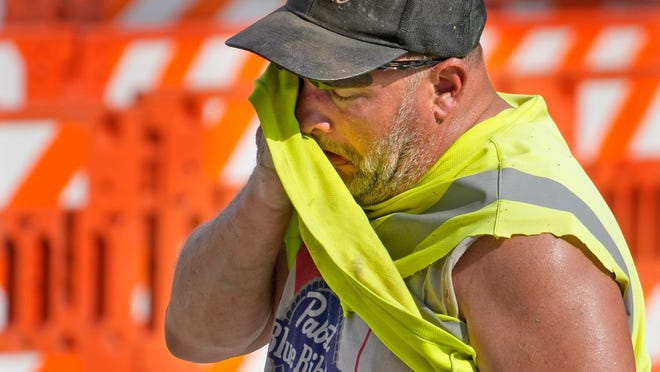Great Falls is scorching hot.
Great Falls is frigid.
During a week of extreme weather across the U.S., it all depends on which Great Falls measures mercury levels.
In Great Falls, Virginia, Luke Mraz dragged a 100-pound hose around a golf course, spraying pond water over acres of parched grass as temperatures soared to 92 degrees.
“It literally feels like the moisture is being sucked out of my body,” the 27-year-old said.
In Great Falls, Montana, the temperature hit 45 degrees, setting a 127-year record, according to the local National Weather Service, and a freak snowstorm hit the mountains in June, drawing a handful of skiers to the local ski resort, Showdown.
“We’re coming off a year with less snow than normal, so the moisture is welcome,” said Avery Patrick, one of the resort’s owners.
Weather across the United States in mid-June saw extreme temperature fluctuations, with a heat wave in the Northeast sending highs into the 90s Fahrenheit, while snowy weather hit the northern Rocky Mountains, dropping the low to 22 Fahrenheit in Eureka, Nevada.
With sweltering heat in the South and chilly temperatures in the Northwest, the National Weather Service has issued warnings of extreme heat and thunderstorms across the Mississippi River Valley and Central Plains, while frost watches have been issued for North Dakota and parts of Nevada and Montana are experiencing record cold temperatures.
About 80 million people from Indiana to New England were under heat watches and warnings, and New York Governor Kathy Hawkle activated a state emergency command in response to high temperatures expected to continue through the weekend.
“This is a deadly event,” Hoekl said a day after the city of Syracuse recorded 94 degrees, breaking the record set in 1994. “We’ve had snowstorms, floods, hurricanes and tornadoes before, but this heat wave is likely to kill more people.”
Chicago recorded a high of 97 degrees at Chicago O’Hare International Airport on Monday, breaking the previous record of 96 degrees set in 1957. Temperatures hovered around 91 degrees on Tuesday, and the heat index, which takes into account temperature and humidity to measure how hot someone feels, reached 95 degrees.
Heat warnings have been issued for areas from the Midwest to northern Maine. Wind chill warnings have been issued for parts of the central and northwestern United States.
Drive just a few states away in any direction and you’ll encounter significant differences in temperatures.
Is climate change to blame?
NWS meteorologist Mark Chenard said record temperatures were also expected in the coming days in Detroit, Philadelphia, New Hampshire, Connecticut and Maine.
Severe weather has hit hundreds of communities across the United States this week, as the Gulf Coast of Texas and Louisiana braced for tropical storm force rains and the Upper Plains region was hit by severe thunderstorms, while dry conditions have sparked wildfires across California and New Mexico that have burned thousands of acres and put the state’s famous vineyards at risk.
It’s too early to tell if the heat is due to climate change, but the heatwave is happening earlier than average, with temperatures in central Maine reaching 30 degrees above normal, he said.
“This is early in the season for a heat wave this long in the Ohio Valley and New England,” Chenard said, adding that it was dangerous because people were unprepared.
New York state will open beaches and public pools early so people can enjoy the Juneteenth holiday on Wednesday, and New York City will open cooling centers for the first time this year as part of its heat stroke prevention plan.
Hot or cold, dry or humid
Some people are taking the weather in stride.
“That’s Montana,” said Michelle Fliginger, a retiree who lives in Belt, a town of a few hundred people. Despite the cold, she plans to go ahead with her summer camping trip this weekend. Montana’s frigid temperatures are expected to last until at least Wednesday morning, with temperatures expected to rise into the 80s to 90s this weekend.
Some are worried: “That’s pretty normal for August, but not June,” said Roger West, who has lived for 12 years in Great Falls, Virginia, a tiny enclave about 20 miles northwest of Washington, D.C. “It’s going to be a long summer if it carries on like this.”
Residents in both parts of Great Falls are seeking shelter indoors, but for opposing reasons: some are seeking refuge from the cold, others from the heat.
West said he had two showers by 2 p.m. Tuesday. Instead of spending hours working on old muscle cars in his garage, a hobby he took up after retirement, he could only work for 20 minutes as fatigue set in.
“I’ve used a lot of water,” he said.
Article contributed by Reuters


